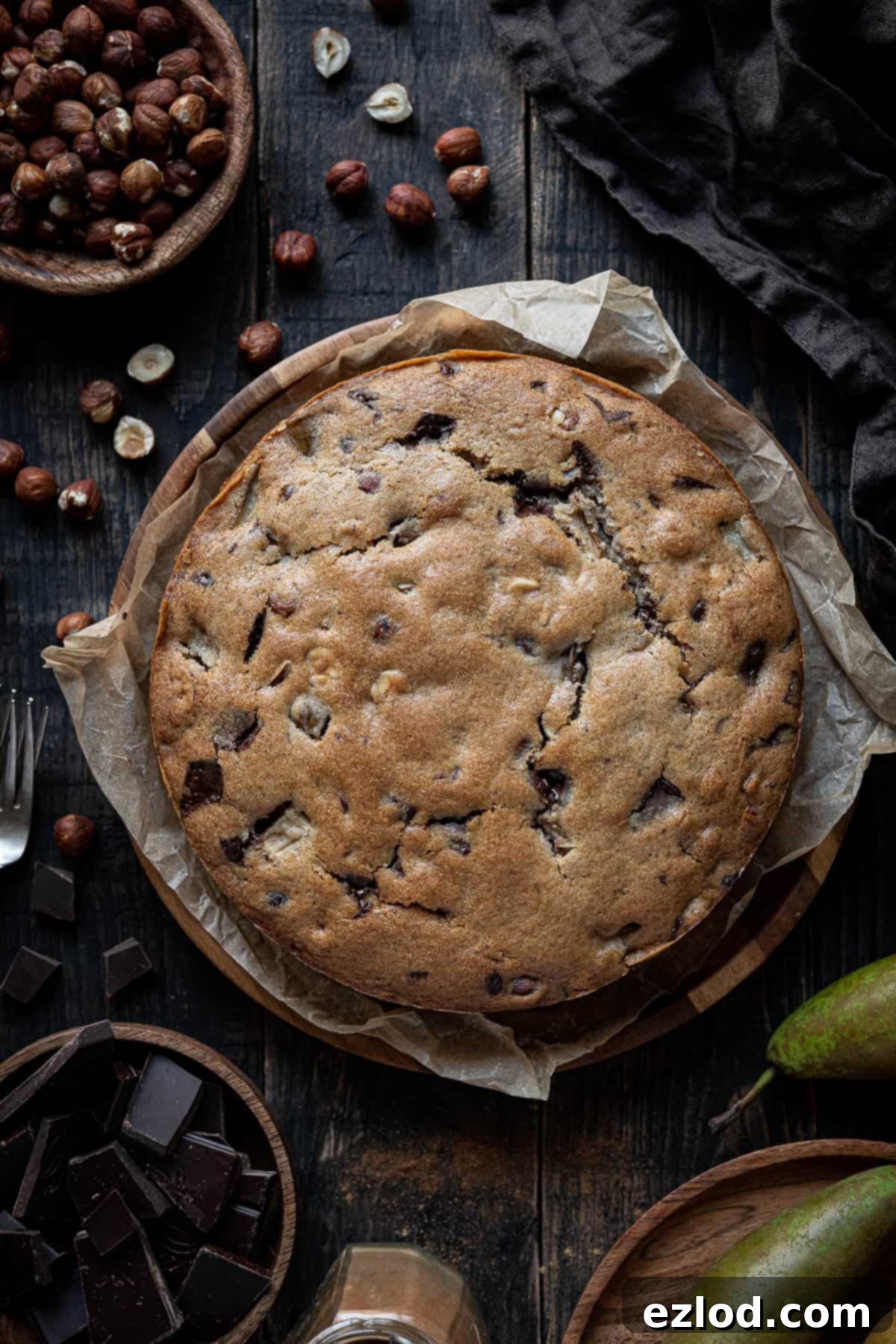Decadent Vegan Chocolate, Pear, and Hazelnut Cake: Your Ultimate Autumnal Treat
Indulge in the rich flavors of autumn with this exquisite vegan chocolate, pear, and hazelnut cake. This delightful plant-based dessert combines the juicy sweetness of ripe pears, the satisfying crunch of toasted hazelnuts, and the luxurious depth of dark chocolate, all infused with a warm hint of cinnamon. It’s a surprisingly easy recipe that promises a moist, tender crumb and a truly comforting experience. Perfect with a steaming cup of tea on a chilly day, or elevated to a show-stopping dessert when served warm with dairy-free custard or a scoop of vanilla bean ice cream.
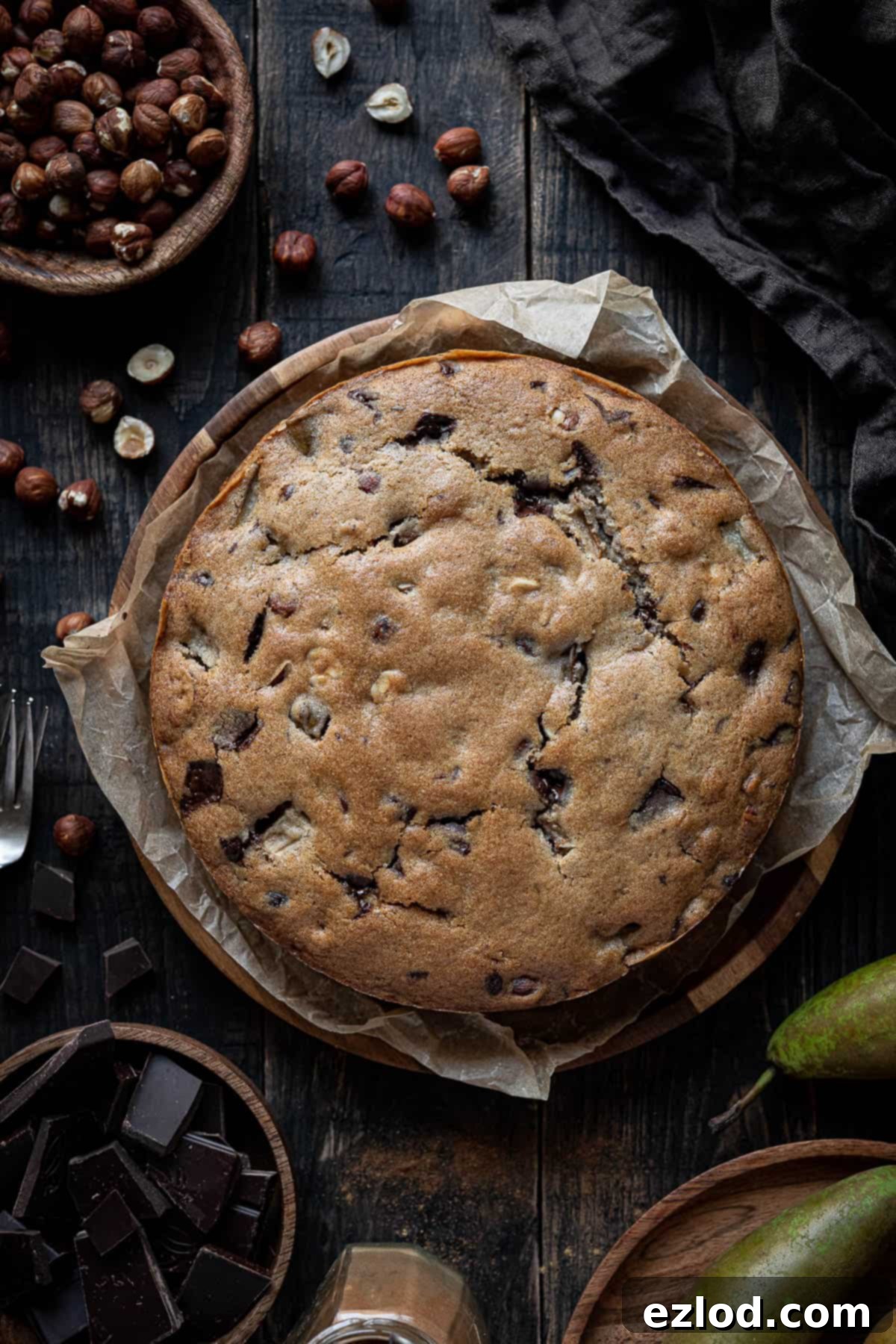
This chocolate, pear, and hazelnut cake recipe holds a special place, being a lovingly veganized rendition of a beloved classic from Domestic Gothess, a recipe that first graced our kitchens all the way back in 2015. Over the years, its charm has only grown, leading to this refined plant-based version that truly captures its original essence while catering to a wider audience.
At its heart, this cake features a wonderfully light yet incredibly moist sponge, subtly fragrant with cinnamon. It’s generously studded with substantial chunks of rich dark chocolate, perfectly toasted and crunchy hazelnuts, and tender pieces of fresh, ripe pear. Each bite offers a harmonious blend of textures and tastes – the melt-in-your-mouth cake, the satisfying snap of chocolate, the earthy crunch of nuts, and the delicate sweetness of fruit.
It stands out as a truly magnificent cake for the cooler months of Autumn and Winter, offering the ultimate cozy indulgence. Imagine enjoying a slice with a hot cup of tea or coffee, wrapped in a blanket as the days grow shorter. Beyond a simple tea-time treat, it effortlessly transforms into a fantastic dessert when served warm. The warmth enhances the chocolate and pear flavors, making it an ideal companion for a dollop of creamy custard or a scoop of your favorite dairy-free ice cream.
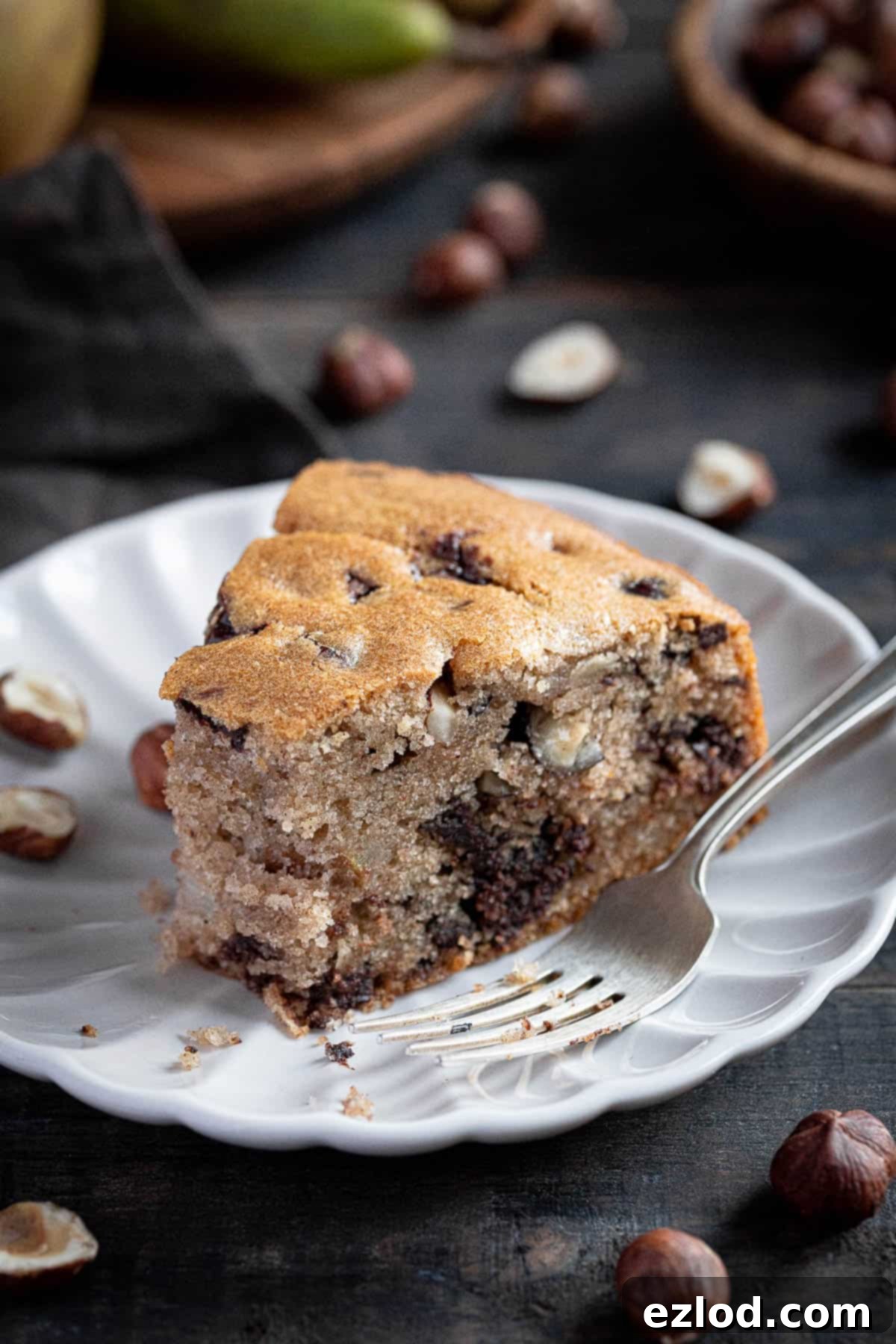
Essential Ingredients for Your Vegan Chocolate, Pear, and Hazelnut Cake:
Crafting a truly exceptional vegan cake relies on understanding the role each ingredient plays. Here’s a detailed look at what you’ll need to create this masterpiece:
Plant Milk: While many varieties of plant milk are available, for optimal baking results, opt for an unsweetened version. Soy milk is often the top choice in vegan baking due to its higher protein content, which mimics some of the structural properties of dairy milk and eggs, contributing to a better texture. However, unsweetened almond or oat milk can also be used successfully, though the final texture might vary slightly.
Non-Dairy Yogurt: This ingredient is a game-changer in vegan cake recipes. Plant-based yogurt acts as a fantastic egg replacer, lending incredible moisture to the cake and contributing a subtle tang that balances the sweetness. Both soy and coconut yogurts work wonderfully, and again, unsweetened is ideal. I personally find the Coconut Collaborative brand to be excellent. While I haven’t extensively tested direct substitutes, Oatly creme fraiche could be a viable alternative due to its similar consistency and fat content. Unsweetened applesauce might also work in a pinch for moisture but could alter the flavor profile more significantly.
Vegan Butter and Oil: This recipe intelligently combines both vegan butter and a neutral oil to achieve the best of both worlds. Vegan block butter (like Naturli Vegan Block or Flora Plant block) provides that classic, rich buttery flavor that’s often missed in vegan baking. Oil, on the other hand, is crucial for ensuring the cake remains exceptionally moist and tender. Avoid spreadable vegan butter from tubs, as their higher water content can negatively impact the cake’s structure. For the oil, sunflower oil is a great choice due to its neutral flavor, but any mild-tasting vegetable oil will suffice.
Vinegar: Don’t skip this seemingly small but mighty ingredient! Vinegar (apple cider vinegar or white wine vinegar are best) reacts with bicarbonate of soda to create carbon dioxide, which is essential for leavening the cake. This reaction helps the cake rise beautifully, resulting in a light and airy texture. Lemon juice can be used as an effective substitute if you don’t have vinegar on hand.
Plain Flour: Standard plain (all-purpose) flour is perfectly suited for this recipe. It’s crucial not to substitute it with wholemeal flour, as the increased fiber content in wholemeal flour can make the cake much denser and heavier than desired. For those interested in a gluten-free version, I recommend using a high-quality gluten-free flour blend designed for baking, along with an additional ¼ teaspoon of xanthan gum if your chosen blend doesn’t already contain it. While I haven’t personally tested a GF version of this specific recipe, similar cake recipes often yield good results with this approach.
Cornflour (Cornstarch): A small addition of cornflour helps to create an even more tender and delicate crumb structure. It lightens the texture of the cake. If you don’t have cornflour, you can simply replace it with an equal amount of plain flour, though the cake may be slightly less soft.
Caster Sugar: Caster sugar (also known as superfine sugar) is preferred for its fine texture, which dissolves easily and contributes to a smooth batter. Granulated sugar can be used interchangeably. However, it’s important to avoid brown sugar, coconut sugar, artificial sweeteners, or liquid sugars, as these alternatives can significantly alter the cake’s moisture content, texture, and overall outcome.
Baking Powder and Bicarb: Utilizing both baking powder and bicarbonate of soda (baking soda) provides the optimal leavening power for this cake. Baking powder acts independently, while bicarbonate of soda needs an acidic ingredient (like the vinegar or yogurt) to activate. Using both ensures a consistent and impressive rise, leading to a perfectly structured cake. Do not attempt to swap one for the other; their chemical properties and reactions are different, and doing so will not yield the same excellent results.
Salt: A pinch of salt is essential in baking. It doesn’t just make the cake taste salty; it enhances and balances all the other flavors, making the chocolate richer and the pear sweeter. Think of it as a flavor amplifier.
Vanilla Extract: For the best flavor, always opt for pure vanilla extract over imitation vanilla essence. Vanilla bean paste is an even more luxurious alternative, offering visible specks of vanilla bean and a more intense flavor profile.
Cinnamon: This recipe calls for a subtle hint of cinnamon, which beautifully complements the autumnal flavors of pear and hazelnut. If you desire a more pronounced spice presence, feel free to increase the amount to your personal preference.
Dark Chocolate: I typically use a 70% dark chocolate, coarsely chopped into varying-sized chunks. This ensures that you get delightful pockets of melting chocolate throughout the cake. Chocolate chips are also a convenient alternative, just ensure they are dairy-free.
Hazelnuts: Hazelnuts provide a wonderful crunch and earthy flavor that pairs exceptionally well with chocolate and pear. However, this ingredient is quite versatile, and you can easily swap them for other nuts like almonds, walnuts, or pecans, all of which would offer a delicious twist.
Pear: The star fruit of this cake! You’ll need one large, ripe pear. A firm but ripe variety like Conference, Bosc, or Anjou is ideal, as they hold their shape well during baking and offer a lovely sweetness and juiciness. Avoid overly soft or mushy pears.
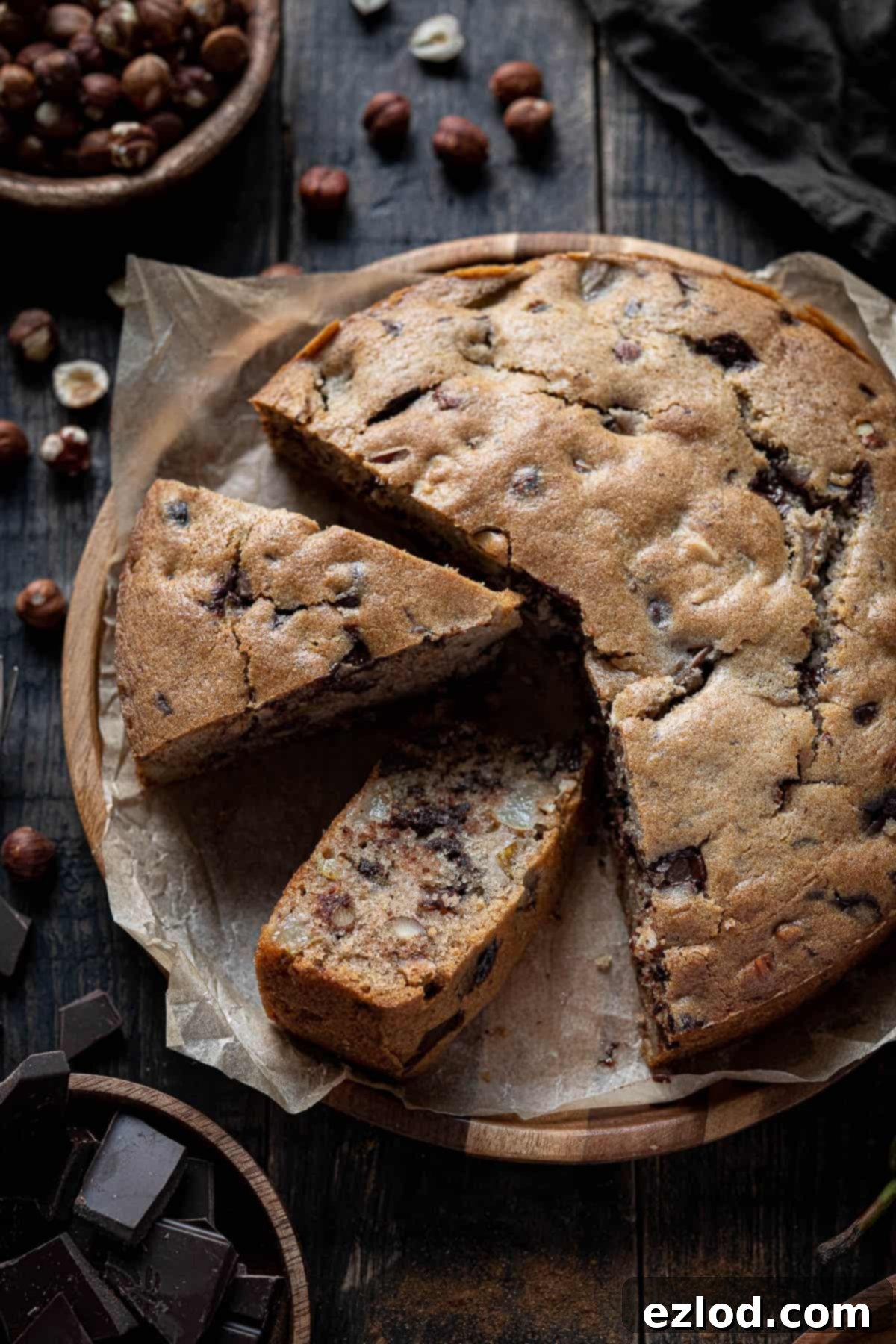
How to Bake the Perfect Vegan Chocolate, Pear, and Hazelnut Cake:
(For precise measurements and detailed step-by-step instructions, please refer to the comprehensive recipe card located at the very bottom of this page)
Begin by preparing your key additions: roughly chop the hazelnuts to ensure a satisfying texture, cut the dark chocolate into irregular chunks for pockets of melted goodness, and core and dice your ripe pear into small, uniform pieces. These will be folded into the batter later.
In a large mixing bowl, meticulously sift together all the dry ingredients: the plain flour, cornflour, baking powder, bicarbonate of soda, cinnamon, and a pinch of salt. Sifting is crucial as it removes any lumps and aerates the mixture, contributing to a lighter cake texture.
In a separate, even larger bowl, combine all the wet ingredients. Whisk together the non-dairy milk, non-dairy yogurt, melted vegan butter, neutral oil, caster sugar, vinegar, and vanilla extract. Whisk vigorously until the mixture is completely homogeneous and the sugar has largely dissolved. This ensures even distribution of flavors and leavening agents.
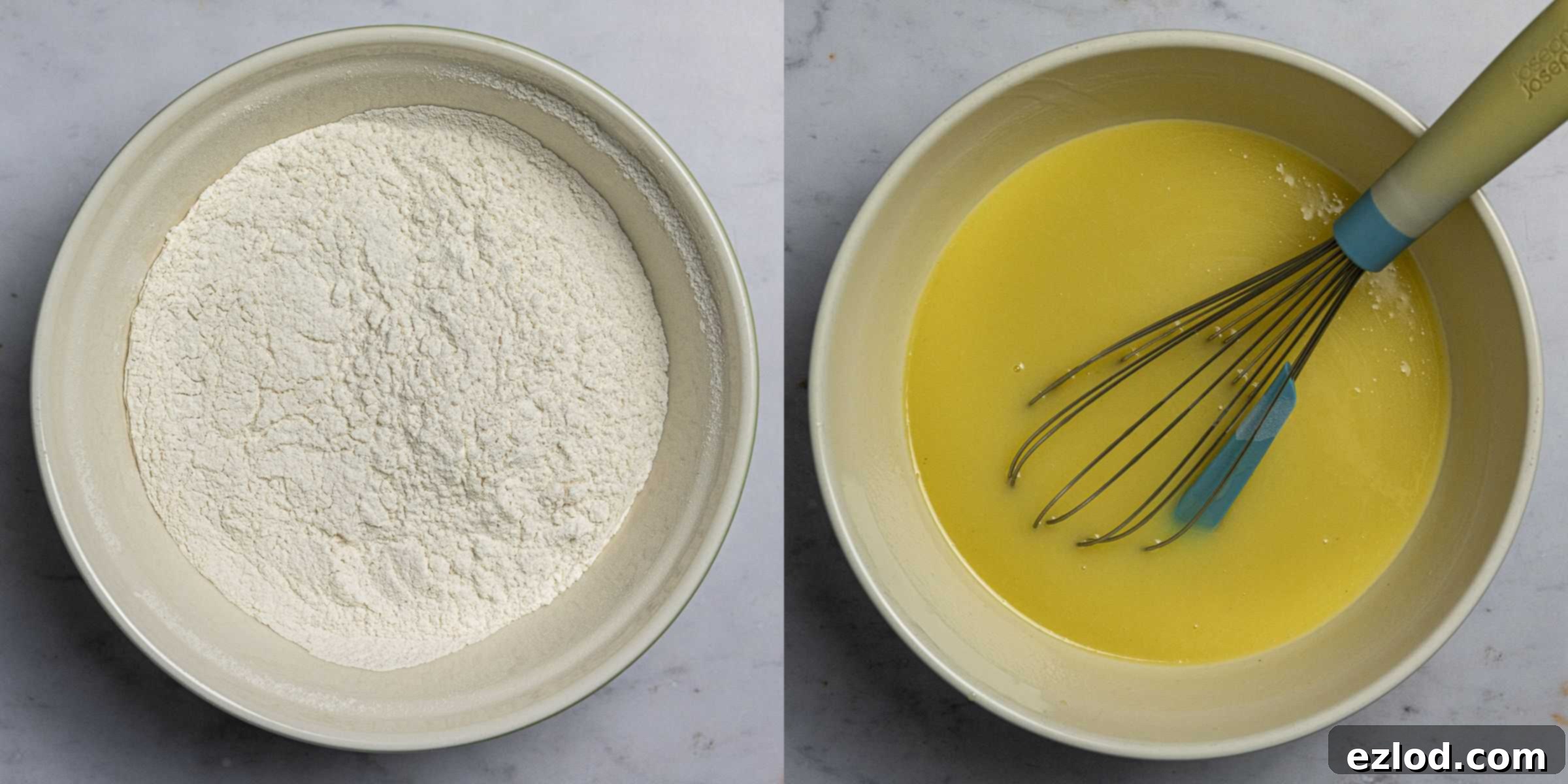
Now, carefully pour the sifted dry ingredients into the bowl containing the wet mixture. Using a balloon whisk, gently mix them together until just combined. It’s important to mix until no dry lumps of flour are visible, but be very careful not to over-mix, as this can develop the gluten in the flour and lead to a tough, chewy cake. A few gentle strokes are usually all it takes.
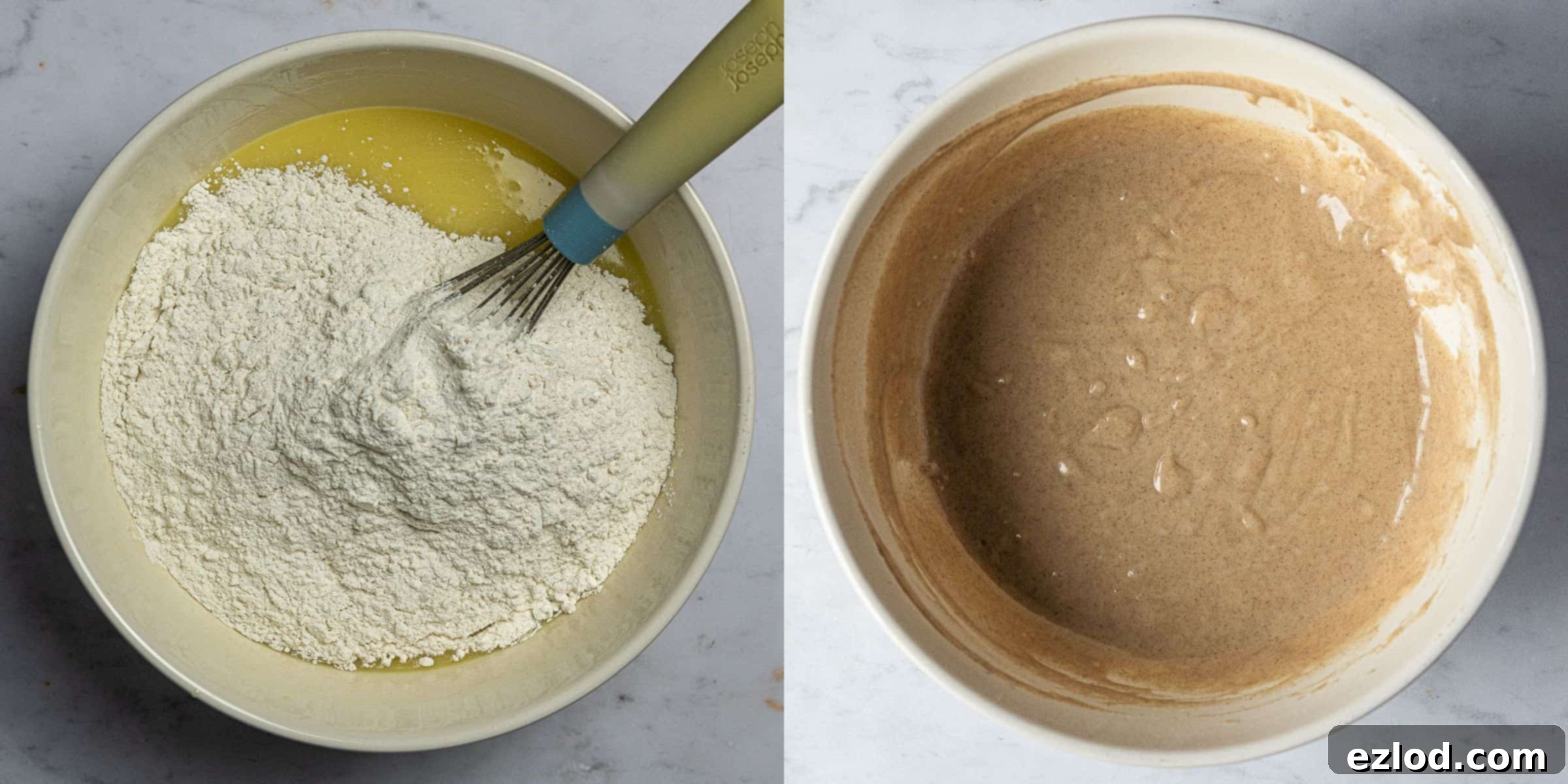
Once the batter is just mixed, it’s time for the delicious additions. Gently fold in the diced pear, chopped hazelnuts, and dark chocolate chunks. Use a spatula for this step to ensure they are evenly distributed throughout the batter without deflating the air you’ve incorporated.
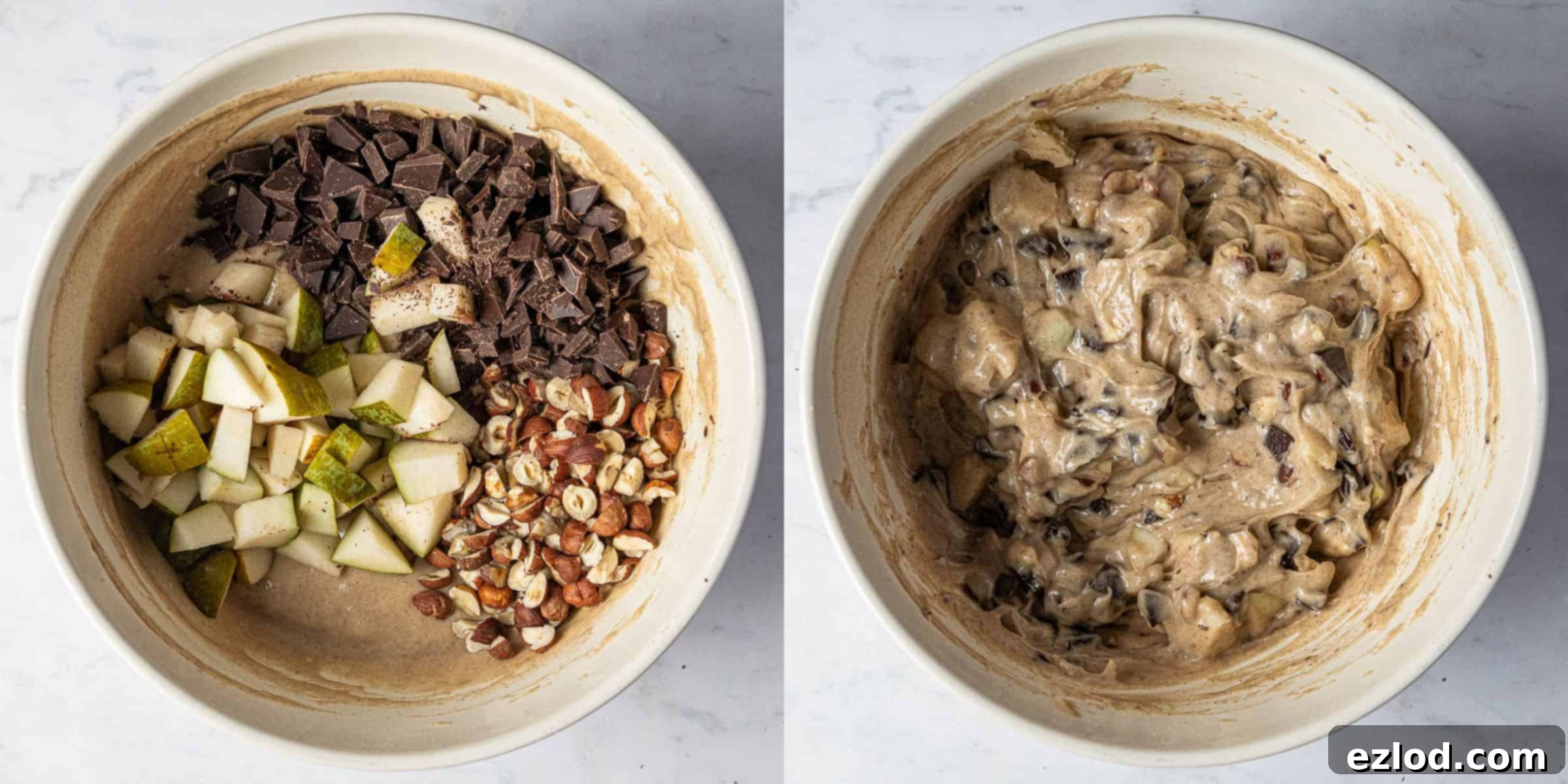
Pour the prepared batter into your greased and lined 20cm/8inch round cake tin. Gently spread the batter evenly to ensure uniform baking. Transfer the tin to your preheated oven and bake for approximately 50-60 minutes. The cake is ready when it feels firm and springy to the touch in the center, and a skewer inserted into the middle (making sure not to hit a piece of chocolate or pear, which can give a false reading) comes out clean. A clean skewer indicates that the cake is thoroughly baked through.
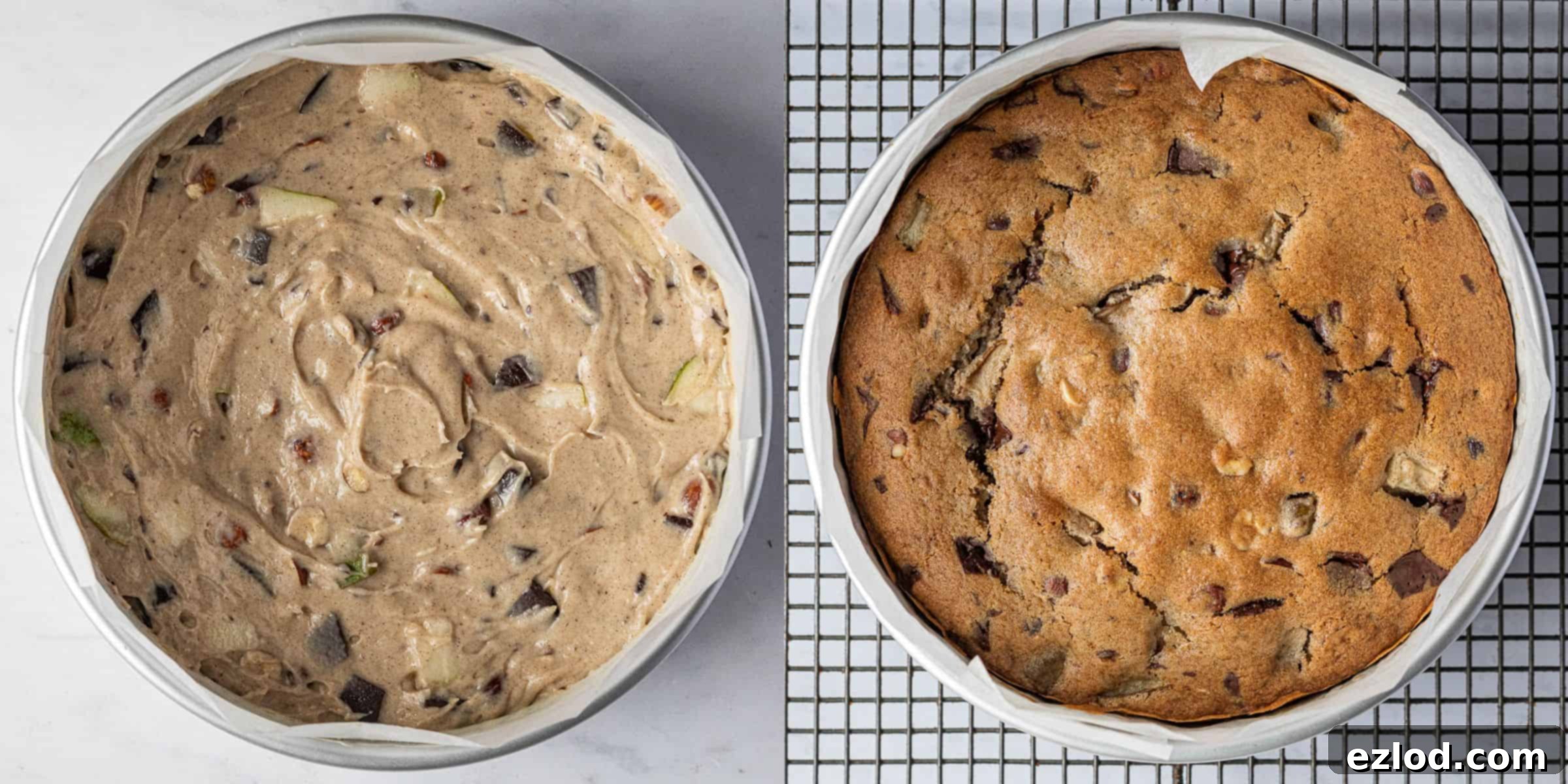
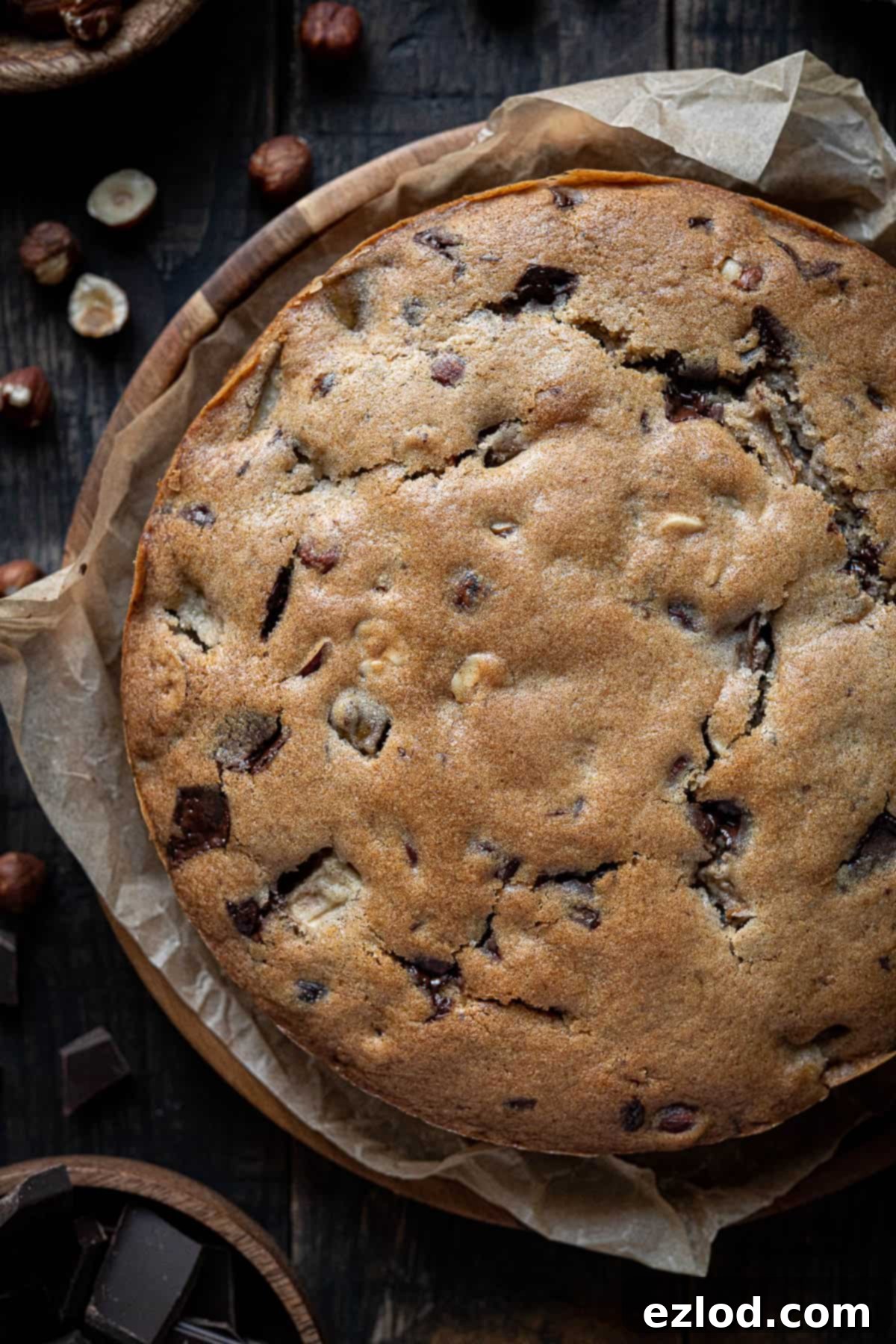
Expert Tips for Vegan Baking Success:
To ensure your vegan chocolate, pear, and hazelnut cake turns out perfectly every time, keep these expert tips in mind:
- Precision in Measurements: As with all my baking recipes, I cannot stress enough the importance of using metric measurements with a digital kitchen scale. Cups, while convenient, are notoriously inaccurate for dry ingredients due to variations in how ingredients are scooped and leveled. Using a scale guarantees consistent, precise results, leading to a much more reliable and delicious cake. It’s also often less messy!
- Follow the Recipe Closely: Baking is a science, and vegan baking, in particular, often relies on a delicate balance of ingredients to achieve the desired texture and rise. For the best possible outcome, adhere to the recipe as closely as possible. Making substitutions or significant changes to the ingredient quantities without understanding their role can drastically alter the final product.
- Avoid Over-Mixing the Batter: This is one of the most common pitfalls in cake baking. Once you combine the wet and dry ingredients, mix only until no dry streaks of flour remain. Over-mixing develops the gluten in the flour, which can result in a dense, tough, and rubbery cake instead of a light, tender one. I highly recommend using a balloon whisk and mixing by hand for better control.
- Thoroughly Mix Separate Components: Before combining the wet and dry ingredients, ensure that each bowl’s contents are extremely well mixed independently. This means whisking the dry ingredients until evenly distributed and whisking the wet ingredients until completely smooth. This way, you minimize the amount of mixing needed once they come together.
- Ingredient Temperature: For best results, ensure your non-dairy milk and yogurt are at room temperature. This helps them emulsify better with the melted vegan butter and oil, creating a smoother batter and a more consistent crumb.
- Cooling Process: Patience is key during the cooling phase. Allow the cake to cool in the tin for about 15-20 minutes before attempting to invert it onto a wire rack. This allows the cake to firm up slightly, reducing the risk of it breaking. Once on the rack, let it cool completely before slicing to ensure it sets properly and holds its shape.
- Storage: This delicious cake stores wonderfully! Keep it in an airtight container at room temperature, and it will remain fresh and moist for approximately 4 days.
- Optional Ganache Topping: While I now prefer this cake plain to let the natural flavors shine, the original version was topped with a luscious chocolate ganache. If you wish to add it, gently heat 125ml (½ cup) of vegan double cream or full-fat coconut cream until it’s just shy of boiling. Pour this hot cream over 100g of finely chopped dark chocolate. Let it sit undisturbed for a couple of minutes to allow the chocolate to melt, then stir until you achieve a silky-smooth ganache. Pour this over the completely cooled cake, letting it drip elegantly down the sides. Finish with a sprinkle of additional chopped hazelnuts for extra texture and visual appeal. Allow the ganache to set before serving for a cleaner cut.
Can I Freeze This Vegan Chocolate, Pear, and Hazelnut Cake?
Absolutely! This vegan chocolate, pear, and hazelnut cake freezes exceptionally well, making it perfect for meal prep or saving a portion for later. To ensure optimal quality and prevent freezer burn, wrap the cooled cake tightly in several layers of plastic wrap, followed by a layer of aluminum foil. You can freeze the entire cake or individual slices for convenience. It will keep beautifully in the freezer for up to 3 months.
When you’re ready to enjoy it, simply allow the cake to defrost slowly at room temperature. For best results, remove it from the freezer several hours before serving or even overnight, depending on the size of the piece. You’ll find it tastes just as fresh and delicious as when it was first baked!
Explore More Fruity Vegan Cake Recipes:
If you loved this delightful cake, you’ll be thrilled to discover more of our plant-based fruit-infused creations:
- Irresistible Vegan Apple Cake
- Delicate Vegan Cherry Almond Cake
- Zesty Vegan Orange Cranberry Cake
- Tropical Vegan Pineapple Upside-Down Cake
- Bright Lemon Blueberry Polenta Cake
- Exotic Vegan Mango Bundt Cake
- Luscious Raspberry, Chocolate and Almond Sheet Cake (Vegan)
- Classic Vegan Apple Bundt Cake
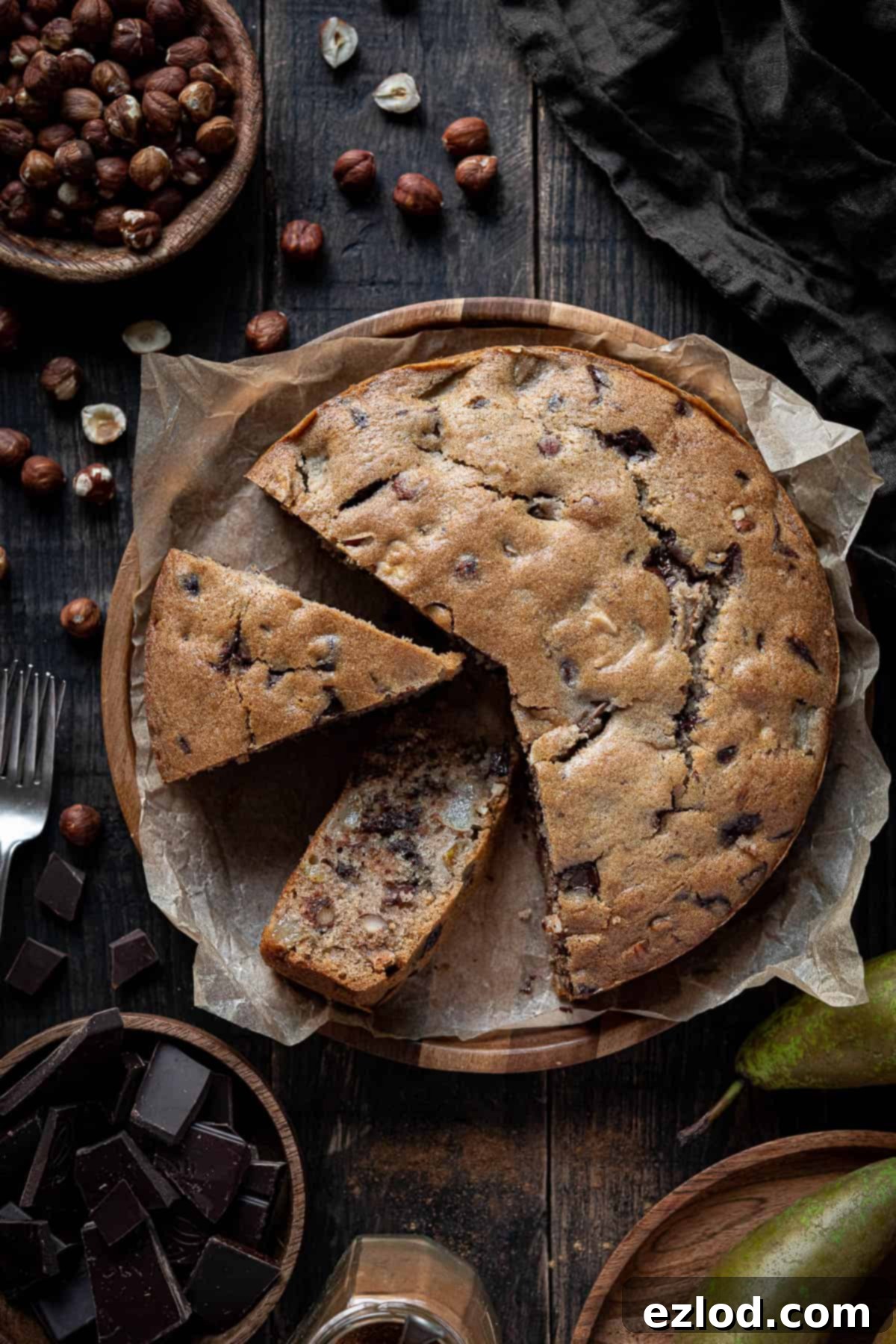
If you’ve had the pleasure of baking this delightful recipe, we would absolutely love to hear about your experience! Please consider rating it, leaving a comment below, or sharing your creation on Instagram. Don’t forget to tag @domestic_gothess and use the hashtag #domesticgothess so we can see your amazing bakes!
All images and content featured on Domestic Gothess are protected by copyright. If you wish to share this recipe with others, please do so by utilizing the convenient share buttons provided on the page. Kindly refrain from screenshotting or posting the recipe or its content in full. Instead, we kindly ask that you include a direct link back to this original post for the recipe. Your understanding and support are greatly appreciated!

Print
Chocolate, Pear And Hazelnut Cake (Vegan)
Ingredients
Cake
- 130 g (4 ½ oz) 70% dark chocolate, chopped into chunks
- 75 g (2 ½ oz) hazelnuts, roughly chopped
- 1 large ripe pear, cored and diced
- 190 g (1 + ⅓ + ¼ cups) plain (all-purpose) flour
- 10 g (1 Tablespoon) cornflour (cornstarch)
- ¾ teaspoon baking powder
- ¼ teaspoon bicarbonate of soda (baking soda)
- 1 rounded teaspoon cinnamon
- pinch salt
- 120 ml (½ cup) unsweetened non-dairy milk (I use soy)
- 60 g (¼ cup) plain non-dairy yogurt (I use coconut), at room temperature
- 60 ml (¼ cup) neutral oil (such as sunflower)
- 60 g (¼ cup) vegan block butter melted and slightly cooled
- 140 g (⅔ cup) caster (superfine) sugar
- 1 ½ teaspoons vanilla extract
- 1 teaspoon vinegar, (apple cider or white wine)
Instructions
-
Begin by preheating your oven to 180°C (160°C fan/350°F/gas mark 4). Prepare your 20cm/8in round cake tin by greasing it thoroughly and lining the bottom and sides with baking parchment. Ensure the tin is at least 5cm/2 inches deep.
-
Next, prepare your mix-ins: roughly chop the hazelnuts to your desired size, chop the dark chocolate into irregular chunks, and then core and dice the ripe pear into small, evenly sized pieces. Set these aside.
-
In a large bowl, meticulously sift together all the dry ingredients: the plain flour, cornflour, baking powder, bicarbonate of soda, ground cinnamon, and a pinch of salt. Sifting helps to aerate the flour and prevents lumps.
-
In a separate, even larger mixing bowl, vigorously whisk together the non-dairy milk, plain non-dairy yogurt, melted vegan block butter, neutral oil, caster sugar, vinegar, and vanilla extract until all these wet ingredients are thoroughly combined and the mixture appears smooth.
-
Gently pour the dry ingredient mixture into the wet ingredients. Using a whisk or a spatula, mix until just combined and no dry pockets of flour remain. Be careful not to over-beat the batter, as this can make the cake tough. Once barely combined, gently fold in the diced pear, chopped hazelnuts, and dark chocolate chunks until evenly distributed throughout the batter.
-
Transfer the cake batter into your prepared tin and spread it level using a spatula. Bake in the preheated oven for 50-60 minutes, or until the top is golden brown, feels firm and springy to the touch, and a skewer inserted into the center (avoiding any chocolate or pear chunks for an accurate reading) comes out clean.
-
Allow the cake to cool in its tin for approximately 20 minutes. This critical step allows the cake to firm up before you attempt to move it. After 20 minutes, carefully invert the cake onto a wire rack and allow it to cool completely before slicing and serving.
Notes
- For all my baking recipes, I highly recommend using metric measurements with a digital scale rather than cup conversions. Measuring by weight is far more accurate and leads to consistently better results, and it’s often cleaner too!
- Refer to the blog post above this recipe card for more detailed tips, ingredient insights, serving suggestions, and step-by-step photos to guide you through the process.
- Achieving the best results means following the recipe precisely as written. Altering any ingredients or their proportions may impact the cake’s final texture and flavor.
- Ensure all wet ingredients (plant milk, yogurt) are at room temperature for optimal batter consistency.
- Avoid over-mixing the batter; mix only until the dry ingredients are just incorporated to maintain a tender crumb.
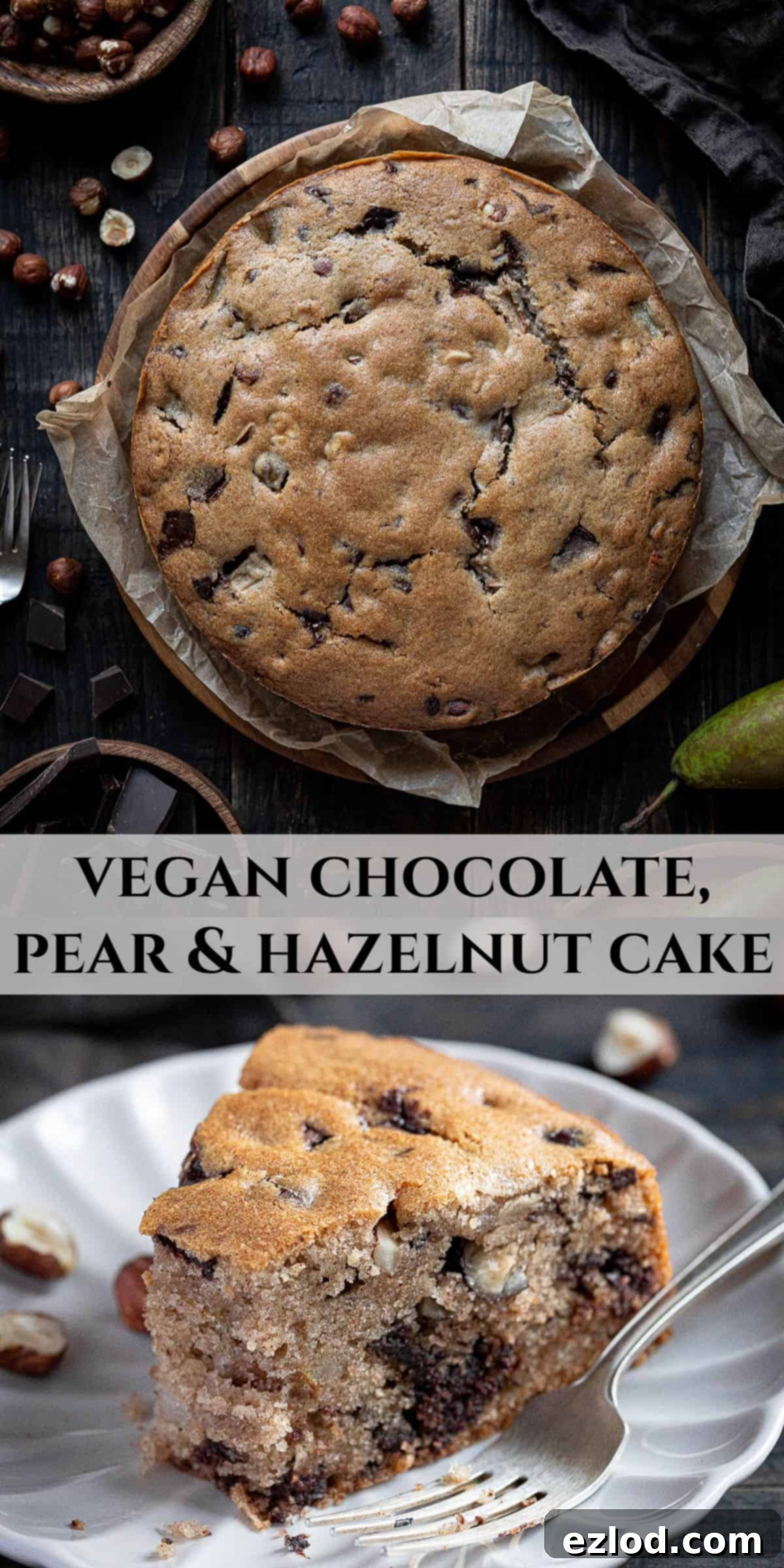
Old (Non-Vegan) Recipe: A Look Back at the Original
This recipe has quite a history! Originally published in 2015, it has since been meticulously updated and veganized to align with plant-based preferences. For those who cherished the classic version or are curious about its origins, I’ve included the original recipe below. It’s a testament to how versatile and adaptable delicious baking can be!
Ingredients:
- 130 g (4 ½ oz) 70% dark chocolate, finely chopped
- 75 g (2 ½ oz) hazelnuts, roughly chopped
- 1 large ripe pear, cored and diced
- 150 g (½ cup + 2 tbsp) softened butter
- 150 g (¾ cup) caster sugar
- 3 large eggs
- 150 g (1 + ¼ cups) plain flour
- 1 tsp baking powder
- 1 tsp cinnamon
- pinch salt
Ganache (Optional for original recipe):
- 100 g (3 ½ oz) 70% dark chocolate, chopped
- 125 ml (½ cup) double cream
- roughly chopped hazelnuts to finish
Instructions
• Preheat the oven to 180C/350F/gas mark 4. Grease a deep 20cm/8in round cake tin and line with baking parchment.
• Cream together the butter and sugar with an electric mixer until pale and fluffy. Beat in the eggs one at a time, beating well after each addition. If the mixture looks like it’s going to split, add a spoonful of the flour.
• In a separate bowl, sift together the flour, baking powder, cinnamon, and salt. Gradually add this dry mixture to the creamed butter and egg mixture, mixing on a low speed until just combined. Gently fold in the chopped chocolate, hazelnuts, and diced pear.
• Scrape the batter into the prepared tin and bake for 40-50 minutes, or until the cake is firm to the touch and a skewer inserted into the center comes out clean. Allow the cake to cool in the tin for approximately 15 minutes before carefully turning it out onto a wire rack to cool completely.
• To prepare the ganache, place the chopped chocolate in a heatproof bowl. Heat the double cream in a small saucepan until it’s just about to boil. Pour the hot cream over the chocolate, let it sit for a couple of minutes to allow the chocolate to melt, then stir until you have a smooth, glossy ganache. Pour the ganache over the top of the cooled cake, allowing it to artfully drip down the sides. Sprinkle with additional roughly chopped hazelnuts and let the ganache set before serving. This adds an extra layer of decadence to the cake.
